Coronation
A coronation is the act of placement or bestowal of a crown upon a monarch's head. The term also generally refers not only to the physical crowning but to the whole ceremony wherein the act of crowning occurs, along with the presentation of other items of regalia, marking the formal investiture of a monarch with regal power. Aside from the crowning, a coronation ceremony may comprise many other rituals such as the taking of special vows by the monarch, the investing and presentation of regalia to the monarch, and acts of homage by the new ruler's subjects and the performance of other ritual deeds of special significance to the particular nation. Western-style coronations have often included anointing the monarch with holy oil, or chrism as it is often called; the anointing ritual's religious significance follows examples found in the Bible. The monarch's consort may also be crowned, either simultaneously with the monarch or as a separate event.
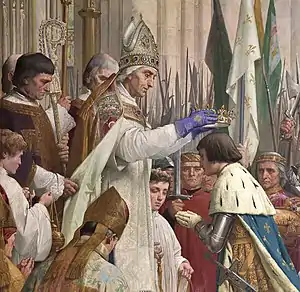
Once a vital ritual among the world's monarchies, coronations have changed over time for a variety of socio-political and religious factors; most modern monarchies have dispensed with them altogether, preferring simpler ceremonies to mark a monarch's accession to the throne. In the past, concepts of royalty, coronation and deity were often inexorably linked. In some ancient cultures, rulers were considered to be divine or partially divine: the Egyptian pharaoh was believed to be the son of Ra, the sun god, while in Japan, the emperor was believed to be a descendant of Amaterasu, the sun goddess. Rome promulgated the practice of emperor worship; in Medieval Europe, monarchs claimed to have a divine right to rule (analogous to the Mandate of Heaven in dynastic China). Coronations were once a direct visual expression of these alleged connections, but recent centuries have seen the lessening of such beliefs.
Coronations are still observed in the United Kingdom, Tonga, and several Asian and African countries. In Europe, most monarchs are required to take a simple oath in the presence of the country's legislature. Besides a coronation, a monarch's accession may be marked in many ways: some nations may retain a religious dimension to their accession rituals while others have adopted simpler inauguration ceremonies, or even no ceremony at all. Some cultures use bathing or cleansing rites, the drinking of a sacred beverage, or other religious practices to achieve a comparable effect. Such acts symbolise the granting of divine favour to the monarch within the relevant spiritual-religious paradigm of the country.
Coronation in common parlance today may also, in a broader sense, refer to any formal ceremony in relation to the accession of a monarch, whether or not an actual crown is bestowed, such ceremonies may otherwise be referred to as investitures, inaugurations, or enthronements. The date of the act of ascension, however, usually precedes the date of the ceremony of coronation. For example, the Coronation of Elizabeth II took place on 2 June 1953, almost sixteen months after her accession to the throne on 6 February 1952 on the death of her father George VI.
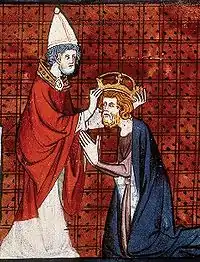
History and development
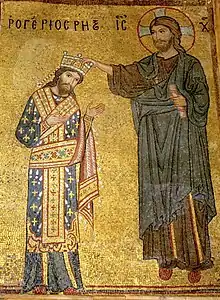
The coronation ceremonies in medieval Christendom, both Western and Eastern, are influenced by the practice of the Roman Emperors as it developed during Late Antiquity, indirectly influenced by Biblical accounts of kings being crowned and anointed.[1] The European coronation ceremonies, perhaps best known in the form they have taken in Great Britain (the most recent of which occurred in 1953), descend from rites initially created in Byzantium, Visigothic Spain, Carolingian France and the Holy Roman Empire and brought to their apogee during the Medieval era.
In non-Christian states, coronation rites evolved from a variety of sources, often related to the religious beliefs of that particular nation. Buddhism, for instance, influenced the coronation rituals of Thailand, Cambodia and Bhutan, while Hindu elements played a significant role in Nepalese rites. The ceremonies used in modern Egypt, Malaysia, Brunei and Iran were shaped by Islam, while Tonga's ritual combines ancient Polynesian influences with more modern Anglican ones.
Antiquity
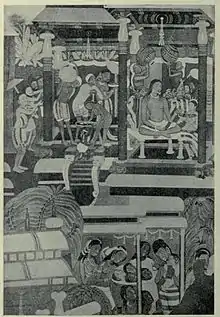
Coronations, in one form or another, have existed since ancient times. Egyptian records show coronation scenes, such as that of Seti I in 1290 BC.[2] Judeo-Christian scriptures testify to particular rites associated with the conferring of kingship, the most detailed accounts of which are found in II Kings 11:12 and II Chronicles 23:11.
The corona radiata, the "radiant crown" known best on the Statue of Liberty, and perhaps worn by the Helios that was the Colossus of Rhodes, was worn by Roman emperors as part of the cult of Sol Invictus, part of the imperial cult as it developed during the 3rd century. The origin of the crown is thus religious, comparable to the significance of a halo, marking the sacral nature of kingship, expressing that either the king is himself divine, or ruling by divine right.
The precursor to the crown was the browband called the diadem, which had been worn by the Achaemenid rulers, was adopted by Constantine I, and was worn by all subsequent rulers of the later Roman Empire. Following the assumption of the diadem by Constantine, Roman and Byzantine emperors continued to wear it as the supreme symbol of their authority. Although no specific coronation ceremony was observed at first, one gradually evolved over the following century. Emperor Julian the Apostate was hoisted upon a shield and crowned with a gold necklace provided by one of his standard-bearers;[3] he later wore a jewel-studded diadem. Later emperors were crowned and acclaimed in a similar manner, until the momentous decision was taken to permit the patriarch of Constantinople to physically place the crown on the emperor's head. Historians debate when exactly this first took place, but the precedent was clearly established by the reign of Leo II, who was crowned by Acacius in 473. This ritual included recitation of prayers by the Byzantine prelate over the crown, a further—and extremely vital—development in the liturgical ordo of crowning. After this event, according to the Catholic Encyclopedia, "the ecclesiastical element in the coronation ceremonial rapidly develop[ed]".[3]
In some European Celtic or Germanic countries prior to the adoption of Christianity, the ruler upon his election was raised on a shield and, while standing upon it, was borne on the shoulders of several chief men of the nation (or tribe) in a procession around his assembled subjects.[1] This was usually performed three times.[1] Following this, the king was given a spear, and a diadem wrought of silk or linen (not to be confused with a crown) was bound around his forehead as a token of regal authority.[1]
Middle Ages
.jpg.webp)
According to Adomnan of Iona, the king of Dal Riata, Áedán mac Gabráin, came to the monastery at Iona in 574 to be crowned by St Columba.[4] In 610, Heraclius arranged a ceremony in Constantinople where he was crowned and acclaimed emperor. In Spain, the Visigothic king Sisenand was crowned in 631, and in 672, Wamba was the first occidental king to be anointed as well, by the archbishop of Toledo. In England, the Anglo-Saxon king Eardwulf of Northumbria was "consecrated and enthroned" in 796, and Æthelstan was crowned and anointed in 925. These practices were nevertheless irregularly used or occurred some considerable time after the rulers had become kings, until their regular adoption by the Carolingian dynasty in France. To legitimate his deposition of the last of the Merovingian kings, Pepin the Short was twice crowned and anointed, at the beginning of his reign in 752, and for the first time by a pope in 754 in Saint-Denis. The anointing served as a reminder of the baptism of Clovis I in Reims in 496, where the ceremony was finally transferred in 816. His son Charlemagne, who was crowned emperor in Rome in 800, passed as well the ceremony to the Holy Roman Empire, and this tradition acquired a newly constitutive function in England too, with the kings Harold Godwinson and William the Conqueror immediately crowned in Westminster Abbey in 1066.
The European coronation ceremonies of the Middle Ages were essentially a combination of the Christian rite of anointing with additional elements. Following Europe's conversion to Christianity, crowning ceremonies became more and more ornate, depending on the country in question, and their Christian elements—especially anointing—became the paramount concern.[1][3] Crowns and sceptres, used in coronations since ancient times, took on a Christian significance together with the orb as symbols of the purported divine order of things, with the monarch as the divinely ordained overlord and protector of his dominion. During the Middle Ages, this rite was considered so vital in some European kingdoms that it was sometimes referred to as an "eighth sacrament".[5] The anointed ruler was viewed as a mixta persona, part priest and part layman, but never wholly either.[1] This notion persisted into the twentieth century in Imperial Russia, where the Tsar was considered to be "wedded" to his subjects through the Orthodox coronation service.[6] Coronation stones marked the site of some medieval ceremonies, though some alleged stones are later inventions.
Crowning ceremonies arose from a worldview in which monarchs were seen as ordained by God[N 1] to serve not merely as political or military leaders, nor as figureheads, but rather to occupy a vital spiritual place in their dominions as well.[5] Coronations were created to reflect and enable these alleged connections; however, the belief systems that gave birth to them have been radically altered in recent centuries by secularism, egalitarianism and the rise of constitutionalism and democracy. During the Protestant Reformation, the idea of divinely ordained monarchs began to be challenged.[7][8]
Modern history
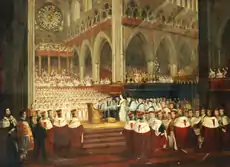
The Age of Enlightenment and various revolutions of the last three centuries all helped to further this trend.[5] Hence, many monarchies—especially in Europe—have dispensed with coronations altogether, or transformed them into simpler inauguration or benediction rites. Majority of contemporary European monarchies today have either long abandoned coronations ceremonies (e.g. Spain, last practiced in 1494) or have never practiced coronations (e.g. Belgium, The Netherlands, Luxembourg). Of all European monarchies today, only the United Kingdom still retains its coronation rite.[3] Other nations still crowning their rulers include Bhutan, Brunei, Cambodia, Lesotho, Swaziland, Thailand, and Tonga, as well as several subnational entities such as the Toro Kingdom. The Papacy retains the option of a coronation, but no pope has used it since 1963 after Pope John Paul I opted for an Inauguration in 1978.[9]
Canonical Coronation
A Canonical Coronation (Latin: coronatio canonica) is a pious institutional act of the Pope, on behalf of a devotion. This tradition still stands in 2015, in 2014 Pope Francis crowned Our Lady of Immaculate Conception of Juquila. Since 1989, the act has been carried out through the authorised decree by the Congregation for Divine Worship and the Discipline of the Sacraments.
Coronations and monarchical power
In most kingdoms, a monarch succeeding hereditarily does not have to undergo a coronation to ascend the throne or exercise the prerogatives of their office. King Edward VIII of the United Kingdom, for example, did not reign long enough to be crowned before he abdicated, yet he was unquestionably the King of the United Kingdom and Emperor of India during his brief reign. This is because in Britain, the law stipulates that in the moment one monarch dies, the new one assumes automatically and immediately the throne; thus, there is no interregnum.[10]
France likewise followed automatic succession, though by tradition the new king ascended the throne when the coffin of the previous monarch descended into the vault at Saint Denis Basilica, and the Duke of Uzès proclaimed "Le Roi est mort, vive le Roi"![N 2][11] In Hungary, on the other hand, no ruler was regarded as being truly legitimate until he was physically crowned with St. Stephen's Crown performed by the archbishop of Esztergom in Székesfehérvár Cathedral (during the Ottoman Empire's invasion of Hungary in Pozsony, then Budapest),[12][13][N 3] while monarchs of Albania were not allowed to succeed or exercise any of their prerogatives until swearing a formal constitutional oath before their respective nations' parliaments. The same still applies in Belgium.[14] Following their election, the kings of Poland were permitted to perform a variety of political acts prior to their coronation, but were not allowed to exercise any of their judicial powers prior to being crowned.[15]
In the Holy Roman Empire an individual became King of the Romans, thus gained governance of the Empire unless he was elected during his predecessor's lifetime, upon his acceptance of the election capitulation, not his coronation. However, prior to Maximilian I he could not style himself "Emperor" until his coronation by the Pope, resulting in many individuals being "Kings of the Romans" or "Kings of Germany," but not "Emperor." Maximilian received Papal permission to call himself "Elected Emperor of the Romans" when he was unable to travel for his coronation. His successors likewise adopted the title with the last Emperor crowned by the Pope being Maxmilian's grandson Charles V.
Official and personal coronation Gifts
The official coronation gifts Royal or Imperial commencing in the 19th century were commissioned by the coronation commission, intended for the incoming monarch, as personal mementos of the coronation event. Personal coronation gifts presented at the coronation festivities directly by the newly crowned monarch to the official coronation guest were similar or identical to the official coronation gift all according to the Royal or Imperial protocol and Court status of the recipient. Presentation of coronation gifts was major anticipated reviling function of the incoming monarch.
Coronation of heirs apparent
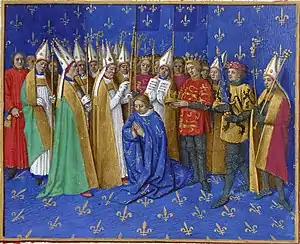
During the Middle Ages, Capetian Kings of France chose to have their heirs apparent crowned during their own lifetime in order to avoid succession disputes.[16][17] This practice was later adopted by Angevin Kings of England, Kings of Hungary and other European monarchs. From the moment of their coronation, the heirs were regarded as junior kings (rex iunior), but they exercised little power and historically were not included in the numbering of monarchs if they predeceased their fathers. The nobility disliked this custom, as it reduced their chances to benefit from a possible succession dispute.[18]
The last heir apparent to the French throne to be crowned during his father's lifetime was the future Philip II, while the only crowned heir apparent to the English throne was Henry the Young King, who was first crowned alone and then with his wife, Margaret of France. The practice was eventually abandoned by all kingdoms that had adopted it, as the rules of primogeniture became stronger. The last coronation of an heir apparent, with the exception of investitures of the Prince of Wales in 1911 and 1969, was the coronation of the future Emperor Ferdinand I of Austria as junior King of Hungary in 1830.[19]
In the modern era
Specific coronation rituals by country, arranged by continent or region, are described in the following articles:
Image gallery
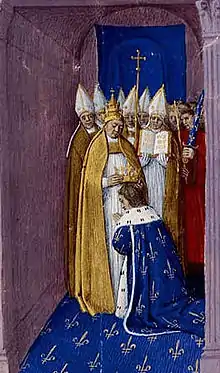 Coronation of Pepin the Short
Coronation of Pepin the Short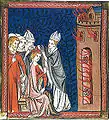 Richard I of England crowned king.
Richard I of England crowned king.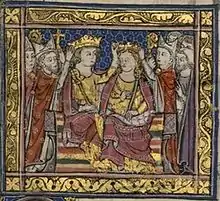 Coronation of Maria of Montferrat and John of Brienne, King of Jerusalem and Latin Emperor of Constantinople
Coronation of Maria of Montferrat and John of Brienne, King of Jerusalem and Latin Emperor of Constantinople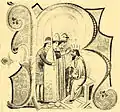 The coronation of Béla IV King of Hungary
The coronation of Béla IV King of Hungary Coronation of Pope Celestine V.
Coronation of Pope Celestine V.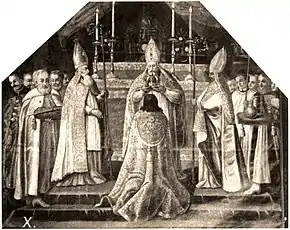 Coronation of John II Casimir Vasa
Coronation of John II Casimir Vasa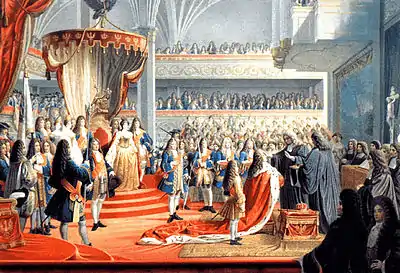 Frederick I of Prussia, being anointed by two Protestant bishops after his coronation at Königsberg in 1701.
Frederick I of Prussia, being anointed by two Protestant bishops after his coronation at Königsberg in 1701.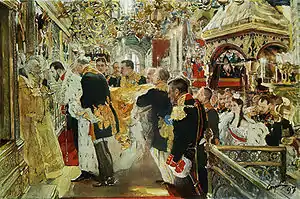 Anointing of Tsar Nicholas II of Russia during his coronation in 1896.
Anointing of Tsar Nicholas II of Russia during his coronation in 1896.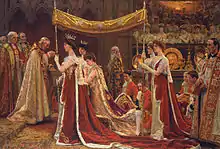 The Anointing of Queen Alexandra at the Coronation of Edward VII
The Anointing of Queen Alexandra at the Coronation of Edward VII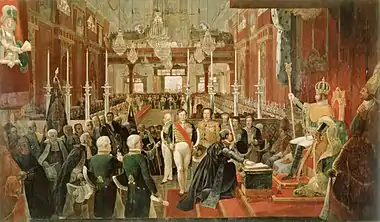 Coronation ceremony of Emperor Pedro I of Brazil in 1822
Coronation ceremony of Emperor Pedro I of Brazil in 1822 Coronation Scene by Dutch painter Abraham Bloemaert
Coronation Scene by Dutch painter Abraham Bloemaert
See also
Bibliography
Coronations: Medieval and Early Modern Monarchic Ritual. ed. Janos M. Bak. University of California Press 1990. ISBN 978-0520066779.
(in German) Bernhard A. Macek: Die Kroenung Josephs II. in Frankfurt am Main. Logistisches Meisterwerk, zeremonielle Glanzleistung und Kulturgueter fuer die Ewigkeit. Peter Lang 2010. ISBN 978-3-631-60849-4.
Zupka, Dušan: Power of rituals and rituals of power: Religious and secular rituals in the political culture of medieval Kingdom of Hungary. IN: Historiography in Motion. Bratislava - Banská Bystrica, 2010, pp. 29–42. ISBN 978-80-89388-31-8.
Notes
This section contains expansions on the main text of the article, as well as links provided for context that may not meet Wikipedia standards for reliable sources, due largely to being self-published.
- Christian references include I Peter 2:13,17 and Romans 13:1-7. Information on the Islamic viewpoint may be found at Islamic Monarchy, from the Science Encyclopedia website.
- English: The [old] king is dead; long live the [new] King!
- An account of this service, written by Count Miklos Banffy, a witness, may be read at The Last Habsburg Coronation: Budapest, 1916. From Theodore's Royalty and Monarchy Website.
References
- Fallow, Thomas Macall (1911). . In Chisholm, Hugh (ed.). Encyclopædia Britannica. 7 (11th ed.). Cambridge University Press. pp. 185–187.
- "Coronation scene of Seti I — Painted Relief, Temple of Abidos, Egypt. 19th. Dynasty 1317 B.C." aurorahistoryboutique.com. Archived from the original on 2005-12-27. Retrieved 2008-08-09.
- Thurston, Herbert (1913). . In Herbermann, Charles (ed.). Catholic Encyclopedia. New York: Robert Appleton Company.
- Adomnan of Iona. The life of St Columba. Penguin Classics, 1995
- Coulombe, Charles A (2005-05-09). "Coronations in Catholic theology". Charles. A Coulombe. Archived from the original on 2008-09-05. Retrieved 2008-09-08.
- Oldenburg, Sergei S. (1975). Last Tsar: Nicholas II, His Reign and His Russia. I. Gulf Breeze, Florida: Academic International Press. pp. 59–60. ISBN 0-686-83125-X.
- Dickens, A.G. (1978). The English Reformation. London & Glasgow: Fontana/Collins. p. 399. ISBN 0-8052-0177-7.
- Ponet, John (1994) [1556]. Patrick S. Poole (ed.). A Shorte Treatise of Politike Power. Patrick S. Poole. Archived from the original on May 31, 2008. Retrieved 2008-09-25.
- Wister, Fr. Robert J. (2002-12-04). "The Coronation of Pope Paul VI". Retrieved 2008-09-25.
- Royal Household. "Accession". Ceremony and Symbol. Retrieved 2011-12-27.
- Giesey, Ralph E. (1990). "Inaugural Aspects of French Royal Ceremonials". In Bak, János M (ed.). Coronations: Medieval and Early Modern Monarchic Ritual. Berkeley: University of California Press. Retrieved 2008-09-25.
- Yonge, Charlotte (1867). "The Crown of St. Stephen". A Book of Golden Deeds Of all Times and all Lands. London, Glasgow and Bombay: Blackie and Son. Retrieved 2008-08-21.
- Nemes, Paul (2000-01-10). "Central Europe Review — Hungary: The Holy Crown". Archived from the original on 2015-05-11. Retrieved 2008-09-26.
- "The Constitution (Belgium), Article 91" (PDF). Parliament of Belgium. Retrieved 2008-09-25.
- Gieysztor, Aleksander (1990). "Gesture in the Coronation Ceremonies of Medieval Poland". In Bak, János M (ed.). Coronations: Medieval and Early Modern Monarchic Ritual. Berkeley: University of California Press. Retrieved 2008-09-25.
- Bartlett, Robert (2003). England Under the Norman and Angevin Kings, 1075-1225. USA: Oxford University Press. ISBN 0-19-925101-0.
- Staunton, Michael (2001). The Lives of Thomas Becket. Manchester University Press. ISBN 0-7190-5455-9. Retrieved 2009-06-23.
- Sedlar, Jean W. (1994). East Central Europe in the Middle Ages, 1000-1500. USA: University of Washington Press. ISBN 0-295-97290-4.
- Taylor, Alan John Percivale (1976). The Habsburg Monarchy, 1809-1918 (Paperback ed.). USA: University of Chicago Press. ISBN 0-226-79145-9. Retrieved 2009-06-23.
| Wikimedia Commons has media related to Coronations. |